
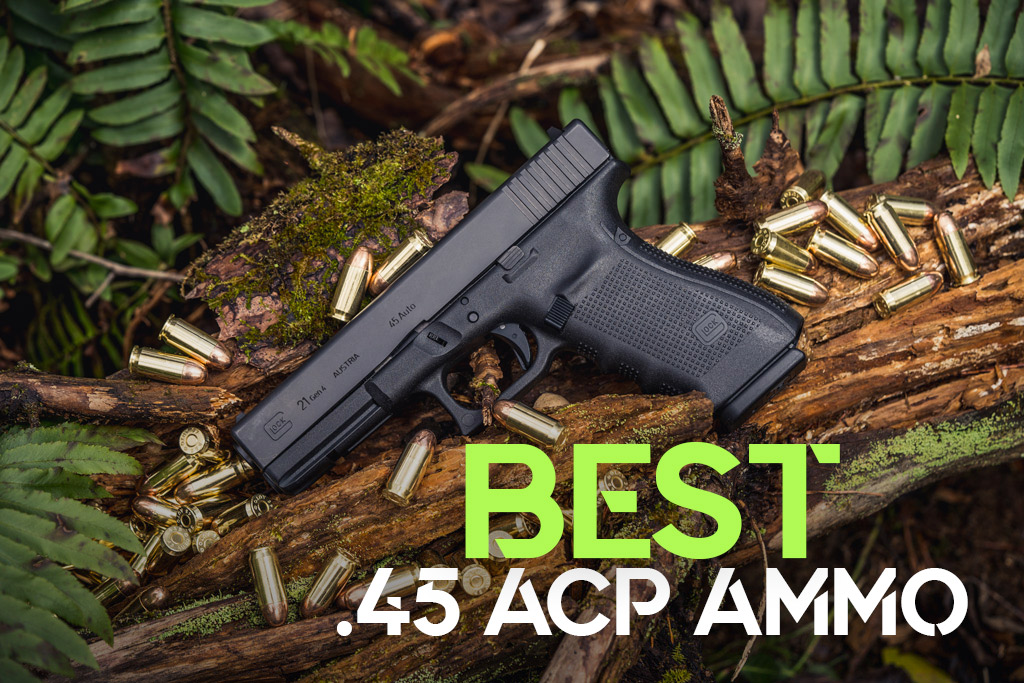
It’s safe to say that the .45 ACP is the undisputed reigning champ of big-bore autoloaders. It didn’t earn this title by sheer power alone, but by its enduring staying power, popularity, and sales volume. There are still law enforcement agencies issuing pistols chambered in and loaded with the best .45 ACP ammo as their duty sidearm. It’s one of many reasons these pistols remain perennial top sellers.
For a cartridge that is well over a century old (as well as the handsome pistol it was tailor-made for), it still sells like crazy. The best 45 ACP ammo is easy to find, because so many manufacturers are making new firearms in that caliber. Take the Springfield Armory XD-S, which was introduced in January, 2012.
Springfield so firmly believed in the viability of the venerable .45 that they introduced their brand new pistol in .45 ACP first, and then expanded to the ever-popular 9mm Luger a year later, followed by the .40 S&W.
Best 45 ACP Ammo: Plinking & Training
Blazer Brass 45 ACP 230 Grain FMJ

Best Bang: Blazer Brass ammo offers gun owners affordable pricing with brass-cased quality.
Blazer Brass is made with reloadable brass cases, and non-corrosive Boxer primers. If you need a case of ammo to take to the range for training, Blazer is your best bet. We’ve personally sent thousands of rounds of Blazer down range and have no complaints about its consistency.
Blazer records 830 feet per second and 352ft/lbs of energy at the muzzle, which is ideal for effective target shooting.
| Caliber | Bullet Type | Bullet Weight | Velocity (Muzzle) | Energy (Muzzle) | 25 Yards (Velocity/Energy) | 50 Yards (Velocity/Energy) | 100 Yards (Velocity/Energy) |
|---|---|---|---|---|---|---|---|
| .45 ACP | FMJ | 230gr | 830 FPS | 352 FT LBS | 809 FPS/334 FT LBS | 794 FPS/322 FT LBS | 760 FPS/295 FT LBS |
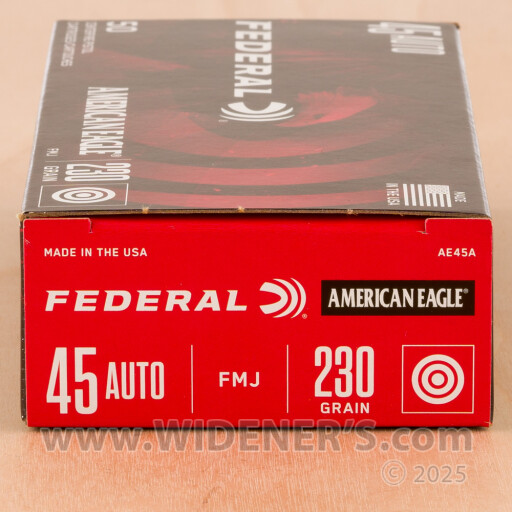
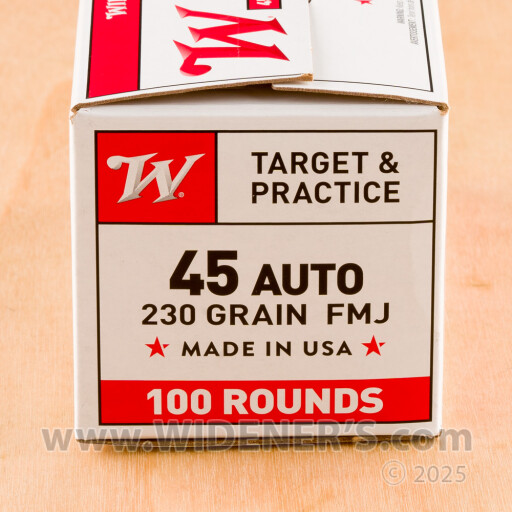
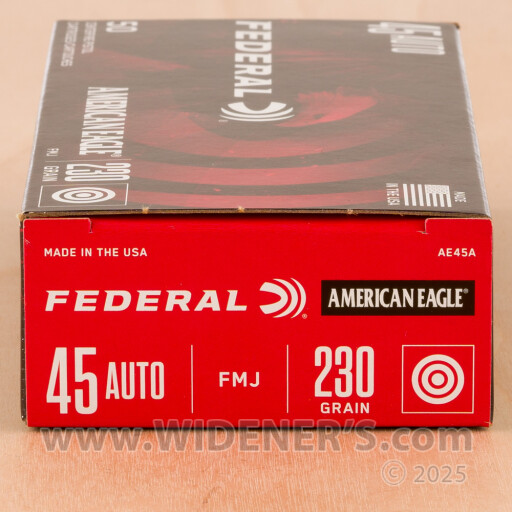
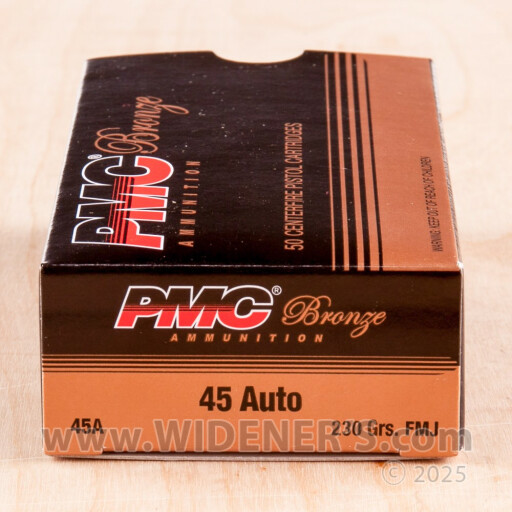
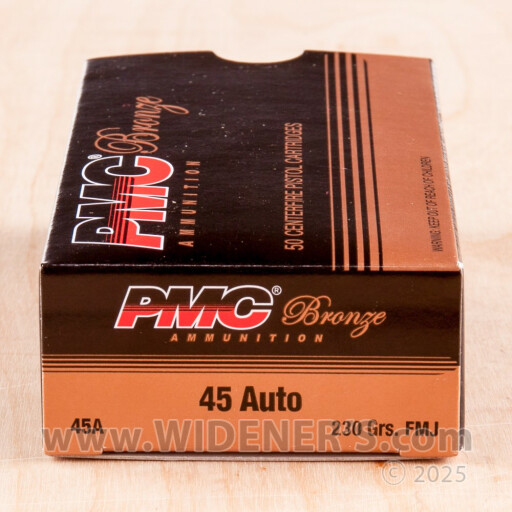
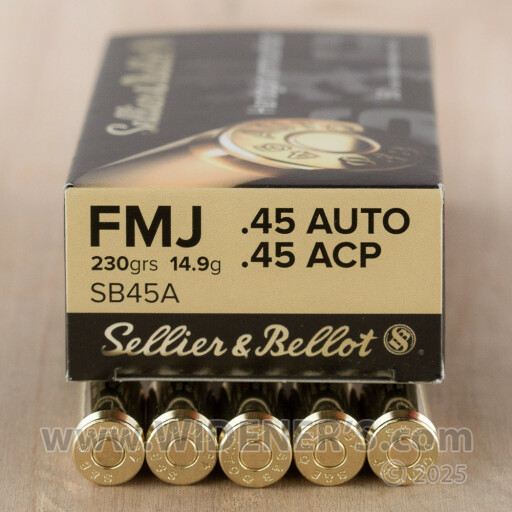
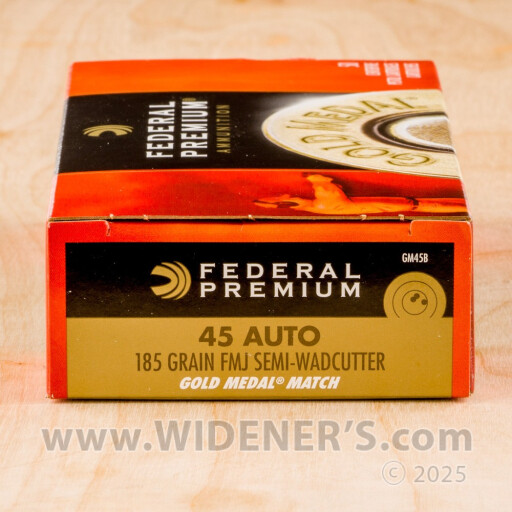
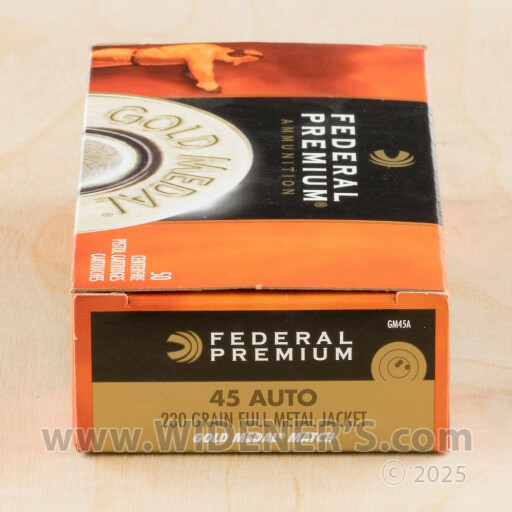
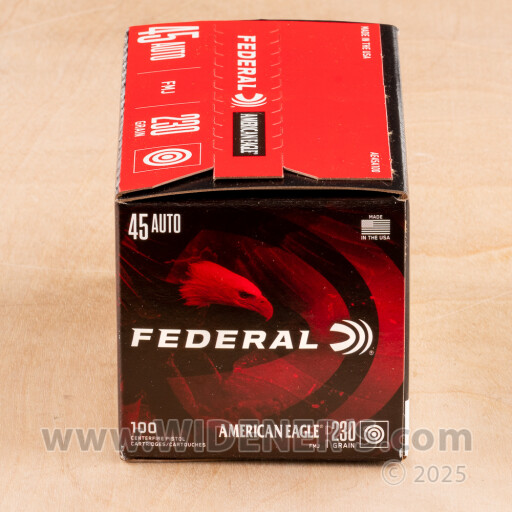
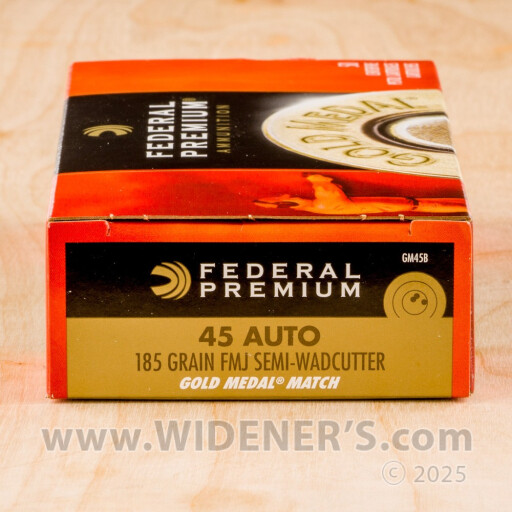
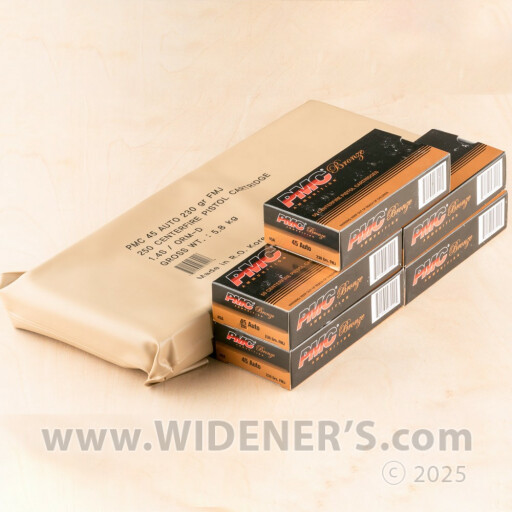
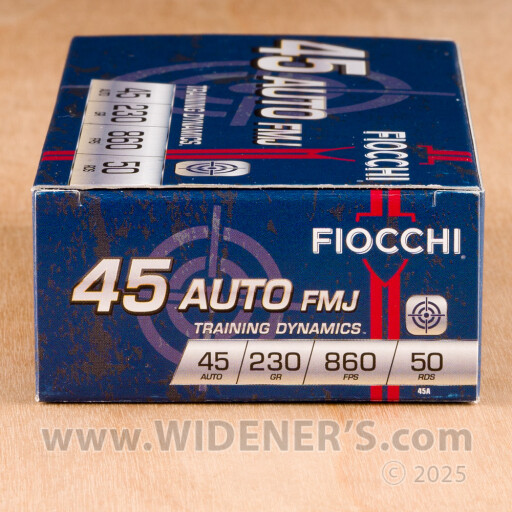
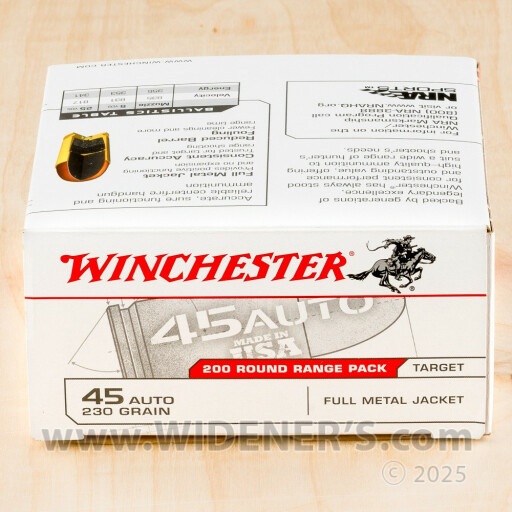
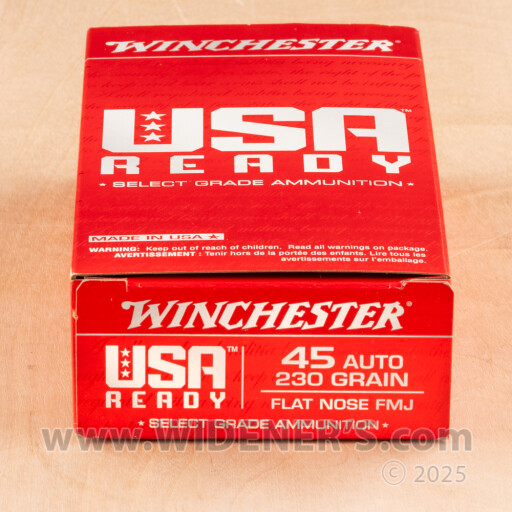
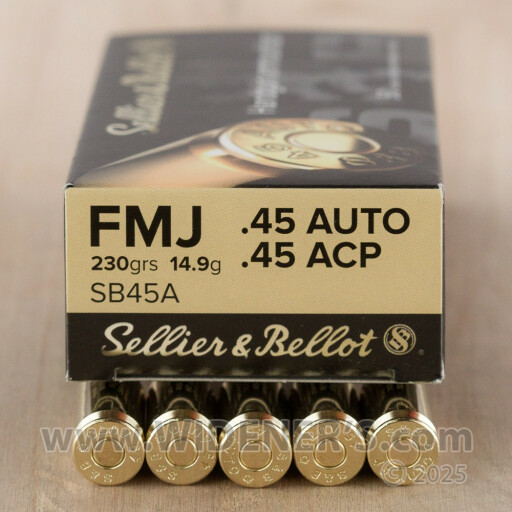
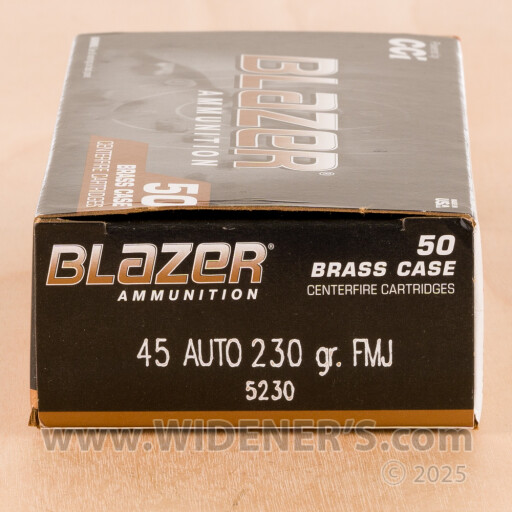
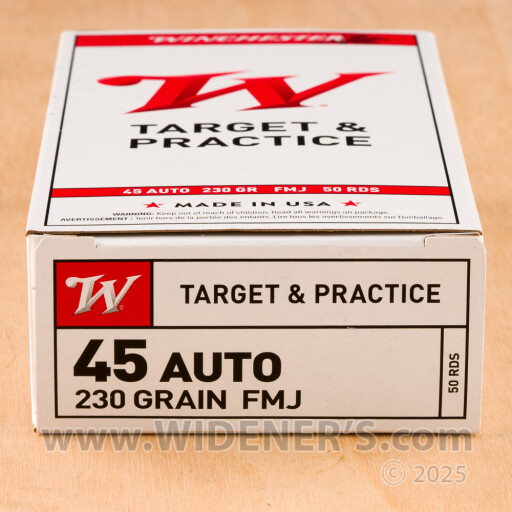
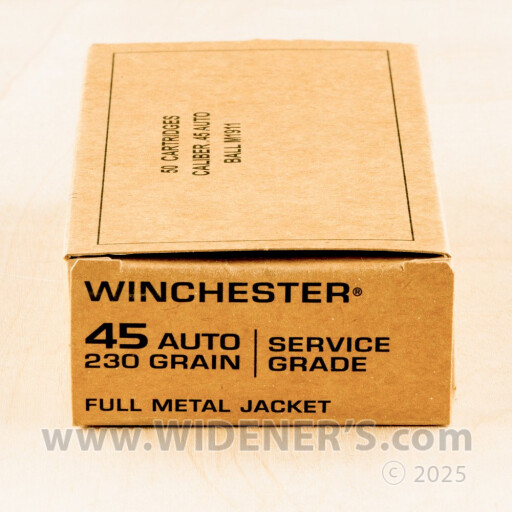
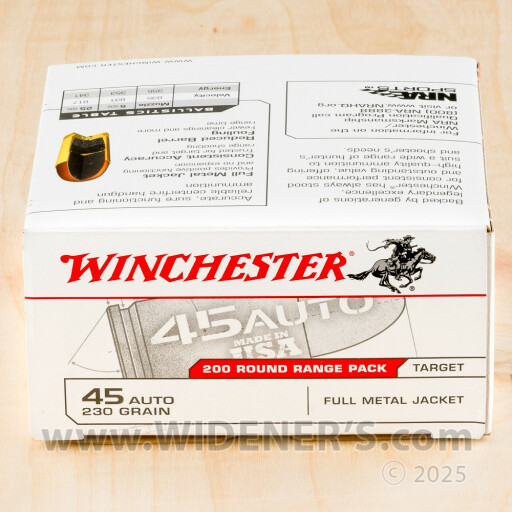
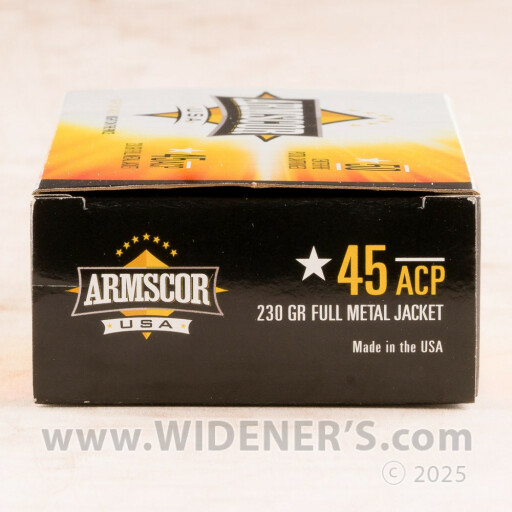
Sellier & Bellot 45 ACP 230 Grain FMJ
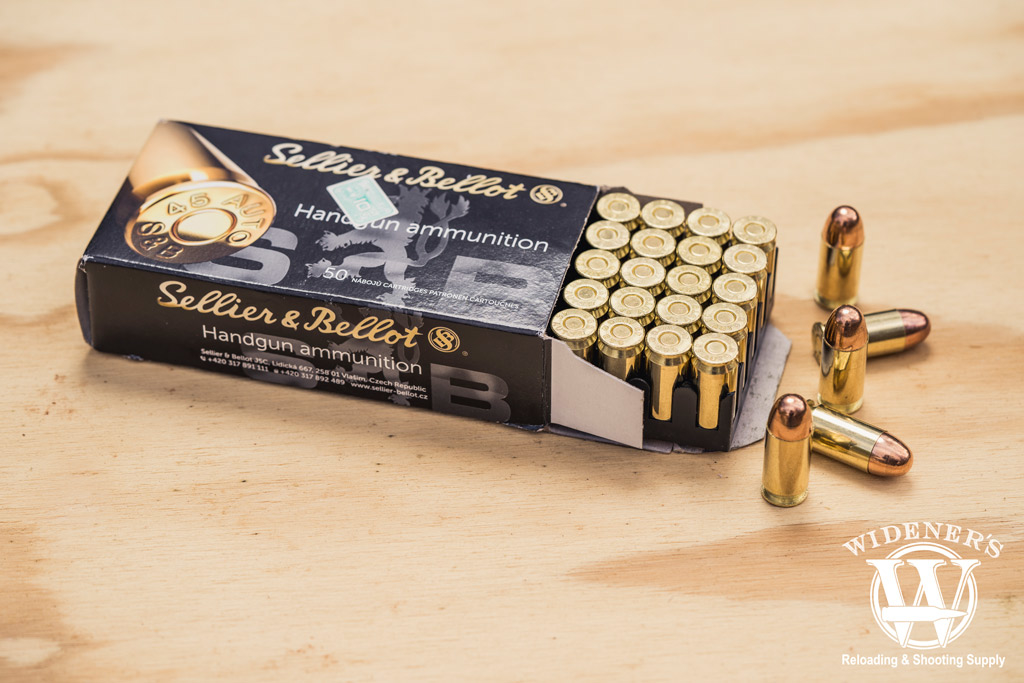
If your .45 is hungry, feeding it rounds from Sellier & Bellot won’t empty your wallet.
The shooting characteristics of the 230gr FMJ target loads are not going to vary a whole lot. They were perfected not long after their commercial release to the market. As the saying goes, if it ain’t broke, don’t fix it.
Sellier & Bellot’s .45 ACP version is a little hotter at 853fps and 372 ft/lbs. These are both very typical numbers for target (non-competition) and plinking loads. You won’t see a difference in performance if you are aiming at targets done the range.
| Caliber | Bullet Type | Bullet Weight | Velocity (Muzzle) | Energy (Muzzle) | 25 Yards (Velocity/Energy) | 50 Yards (Velocity/Energy) | 100 Yards (Velocity/Energy) |
|---|---|---|---|---|---|---|---|
| .45 ACP | FMJ | 230gr | 853 FPS | 372 FT LBS | 839 FPS/359 FT LBS | 824 FPS/347 FT LBS | 798 FPS/325 FT LBS |




















Best 45 ACP Range Training Ammo
Winchester Service Grade 45 ACP 230 Grain FMJ

Winchester is one of the oldest players in the ammo game for a good reason, they deliver consistant quality.
While affordable .45 ACP rounds are decent for blazing away at zombie silhouettes and hostile Coors cans, qualification day does demand something of a higher quality. Winchester Service Grade is intended for those who shoot a lot and demand reliable, clean-burning target ammo. If that’s you, then this is your ammo. Boxer-primed and using virgin, new brass, this cartridge will keep your favorite rig firing straight and level throughout the competition.
| Caliber | Bullet Type | Bullet Weight | Velocity (Muzzle) | Energy (Muzzle) | 25 Yards (Velocity/Energy) | 50 Yards (Velocity/Energy) | 100 Yards (Velocity/Energy) |
|---|---|---|---|---|---|---|---|
| .45 ACP | FMJ | 230gr | 865 FPS | 382 FT LBS | 845 FPS/365 FT LBS | 830 FPS/352 FT LBS | 800 FPS/327 FT LBS |

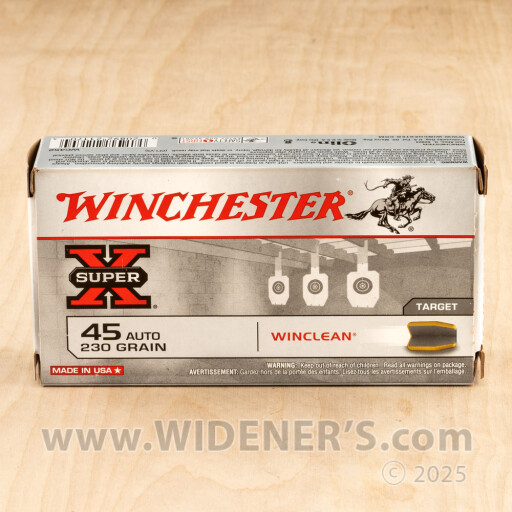





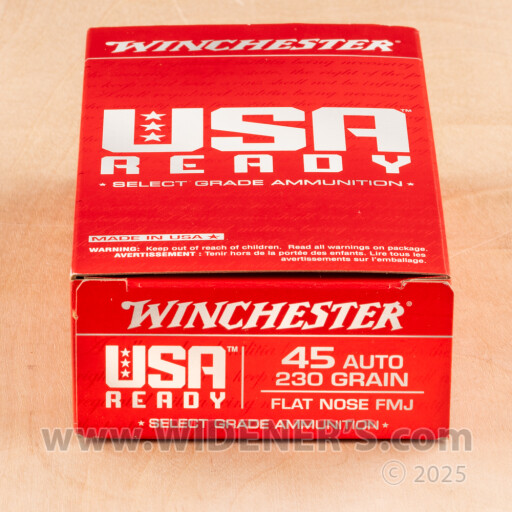
Federal American Eagle Non-Toxic Primer 45 ACP 230 Grain TMJ
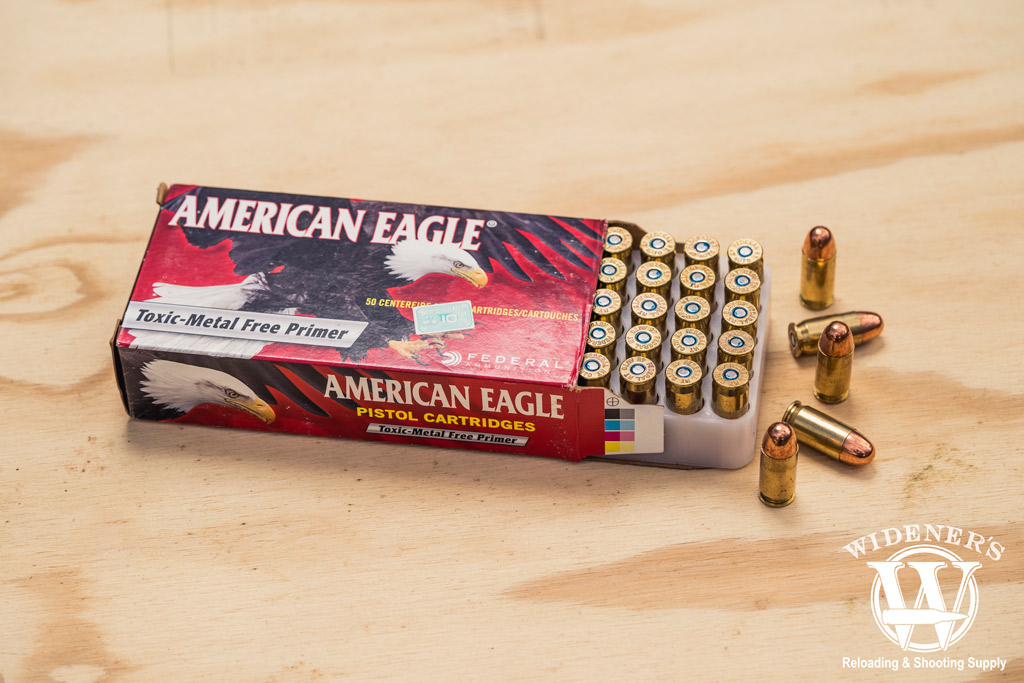
If you shoot at an indoor range, the non-toxic TMJ bullet by Federal is an excellent training option.
Made specifically with the indoor range shooters in mind, American Eagle total metal jacket (TMJ) is a non-toxic alternative to traditional FMJ bullets, which by design are not actually fully jacketed. TMJ bullets fully encase the lead core to include the base of the bullet. They also are loaded with primers that are free from all toxic metals.
| Caliber | Bullet Type | Bullet Weight | Velocity (Muzzle) | Energy (Muzzle) | 25 Yards (Velocity/Energy) | 50 Yards (Velocity/Energy) | 100 Yards (Velocity/Energy) |
|---|---|---|---|---|---|---|---|
| .45 ACP | TMJ | 230gr | 850 FPS | 369 FT LBS | 834 FPS/355 FT LBS | 819 FPS/343 FT LBS | 790 FPS/319 FT LBS |
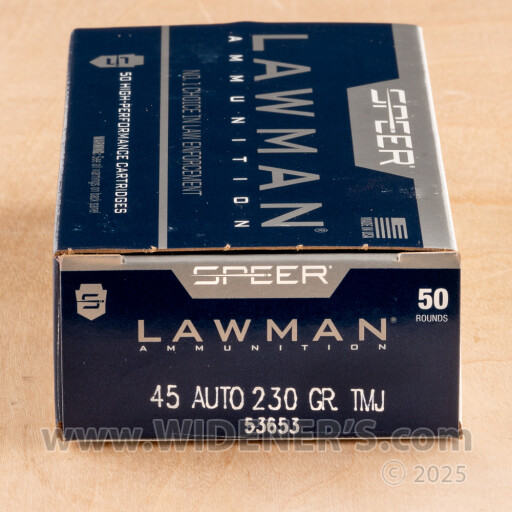
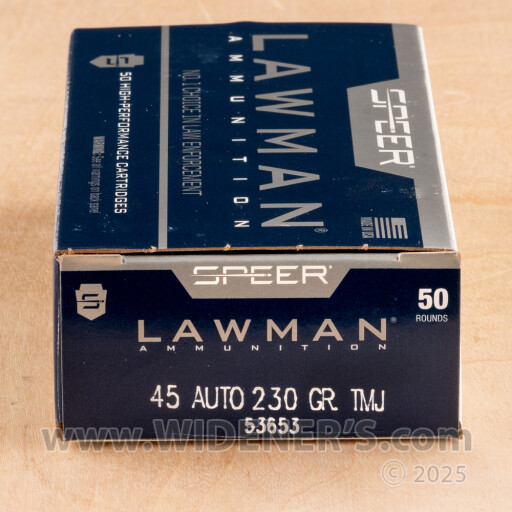
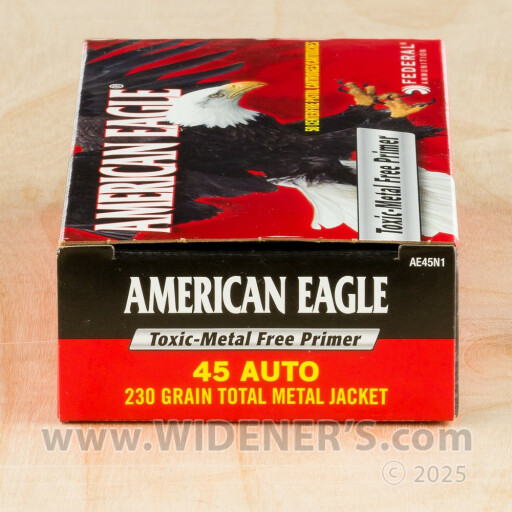
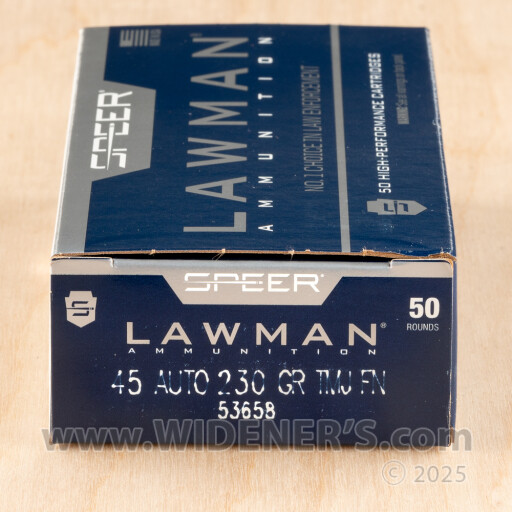
Best 45 ACP Ammo for Home Defense
Speer LE Gold Dot 45 ACP 230 Grain JHP
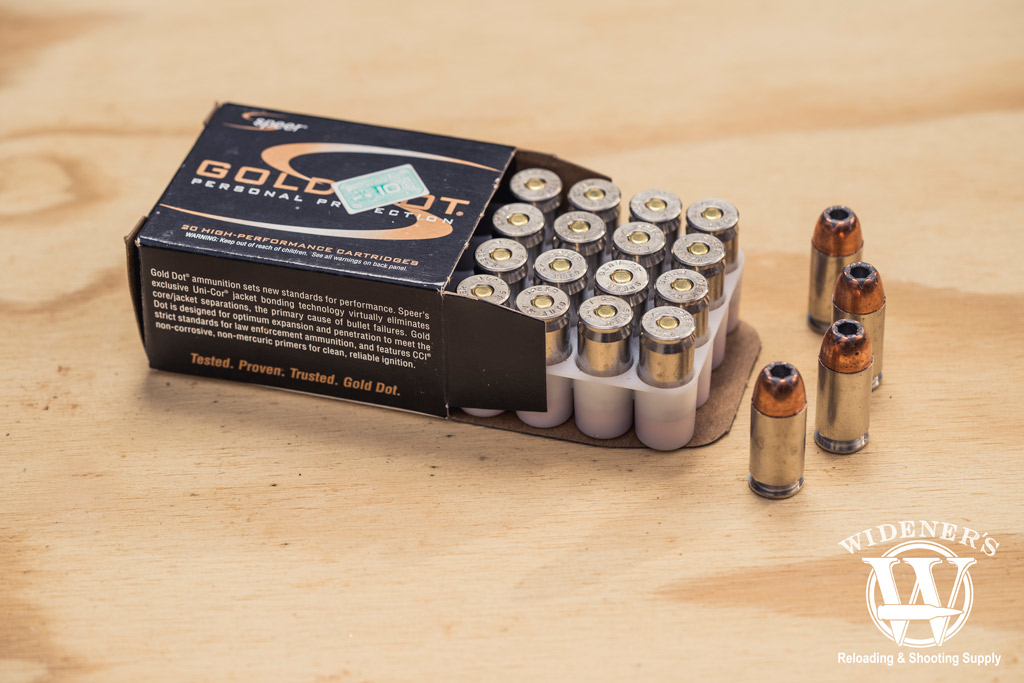
Ask a LEO what they carry in their duty gun, and they’ll likely tell you it’s a Speer Gold Dot product.
Designed to provide consistent shot-to-shot expansion, with accurate and reliable results, Speer Gold Dot has been around for a long time. There’s a reason many new manufacturers have tried to mimic the Speer bullet. Take a look at any independent ballistics test and it’s always near the top of the list. The LE version is tailored for duty use to ensure that assailants are incapacitated first-shot.
| Caliber | Bullet Type | Bullet Weight | Velocity (Muzzle) | Energy (Muzzle) | 25 Yards (Velocity/Energy) | 50 Yards (Velocity/Energy) | 100 Yards (Velocity/Energy) |
|---|---|---|---|---|---|---|---|
| .45 ACP | JHP | 230gr | 890 FPS | 404 FT LBS | 867 FPS/384 FT LBS | 845 FPS/365 FT LBS | 805 FPS/331 FT LBS |
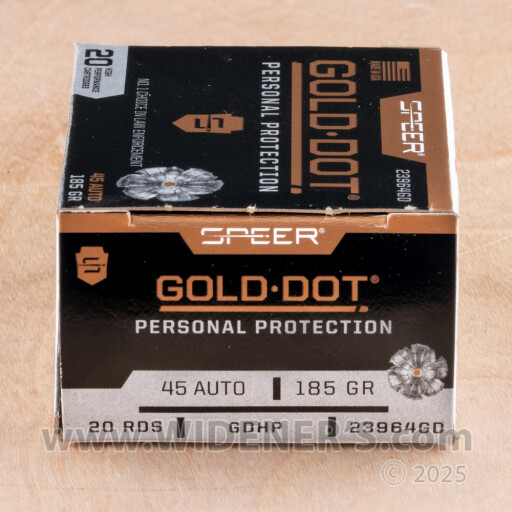


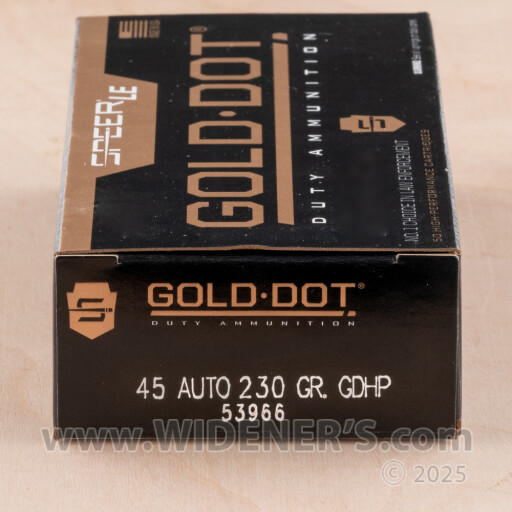

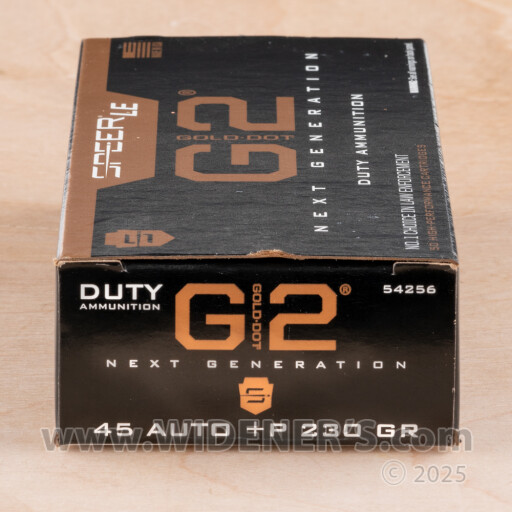
Federal 45 ACP 230 Grain HST JHP
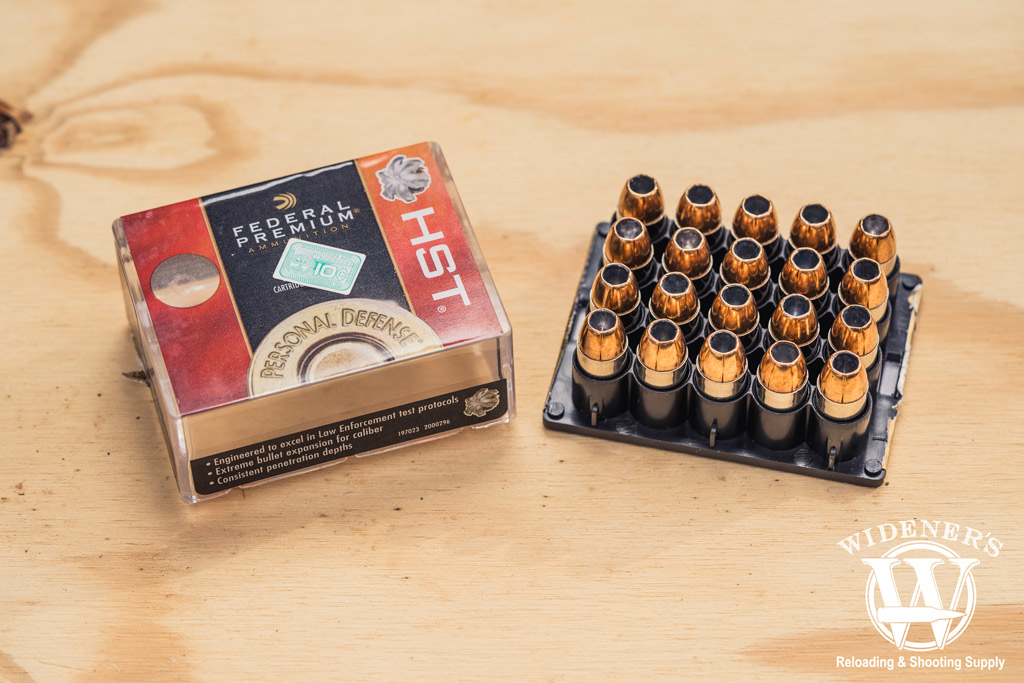
When Federal HST was originally released to the market, sales were restricted to law enforcement agencies and personnel.
Federal Premium HST .45 ACP 230-grain bullets are an excellent self-defense option. Law enforcement agencies worldwide trust them due to their consistent performance, excellent stopping power, and reliability.
These projectiles have a muzzle velocity of 890 FPS. They produce 404 ft-lbs of muzzle energy.
| Caliber | Bullet Type | Bullet Weight | Velocity (Muzzle) | Energy (Muzzle) | 25 Yards (Velocity/Energy) | 50 Yards (Velocity/Energy) | 100 Yards (Velocity/Energy) |
|---|---|---|---|---|---|---|---|
| .45 ACP | JHP | 230gr | 890 FPS | 404 FT LBS | 872 FPS/389 FT LBS | 856 FPS/374 FT LBS | 824 FPS/347 FT LBS |
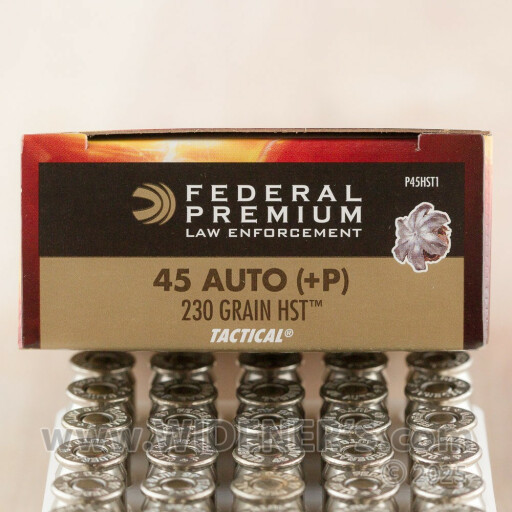
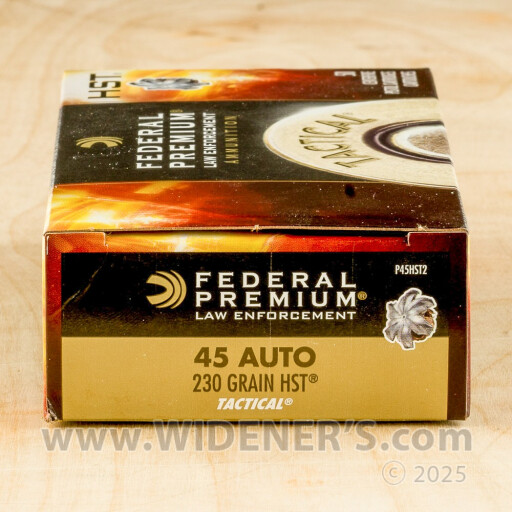
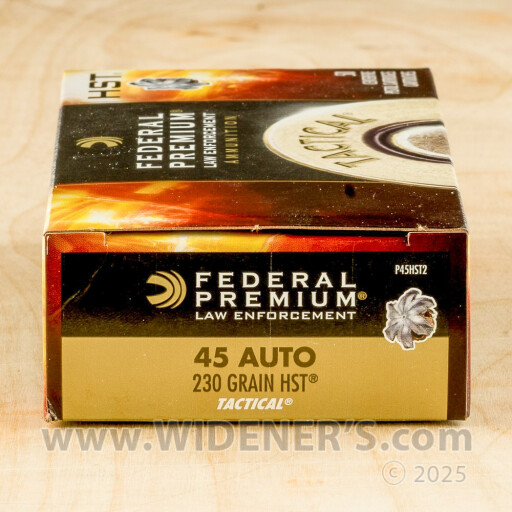

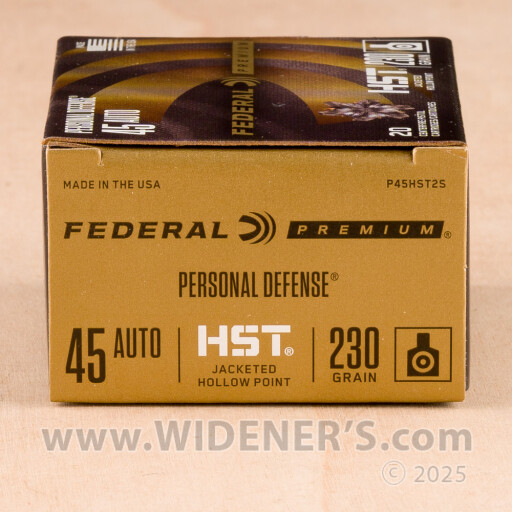
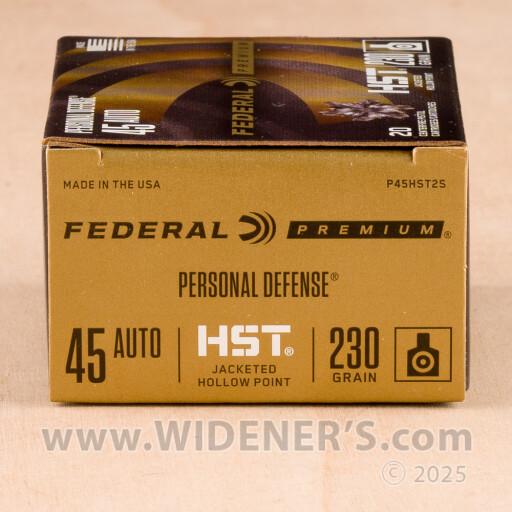
Cartridge Specs
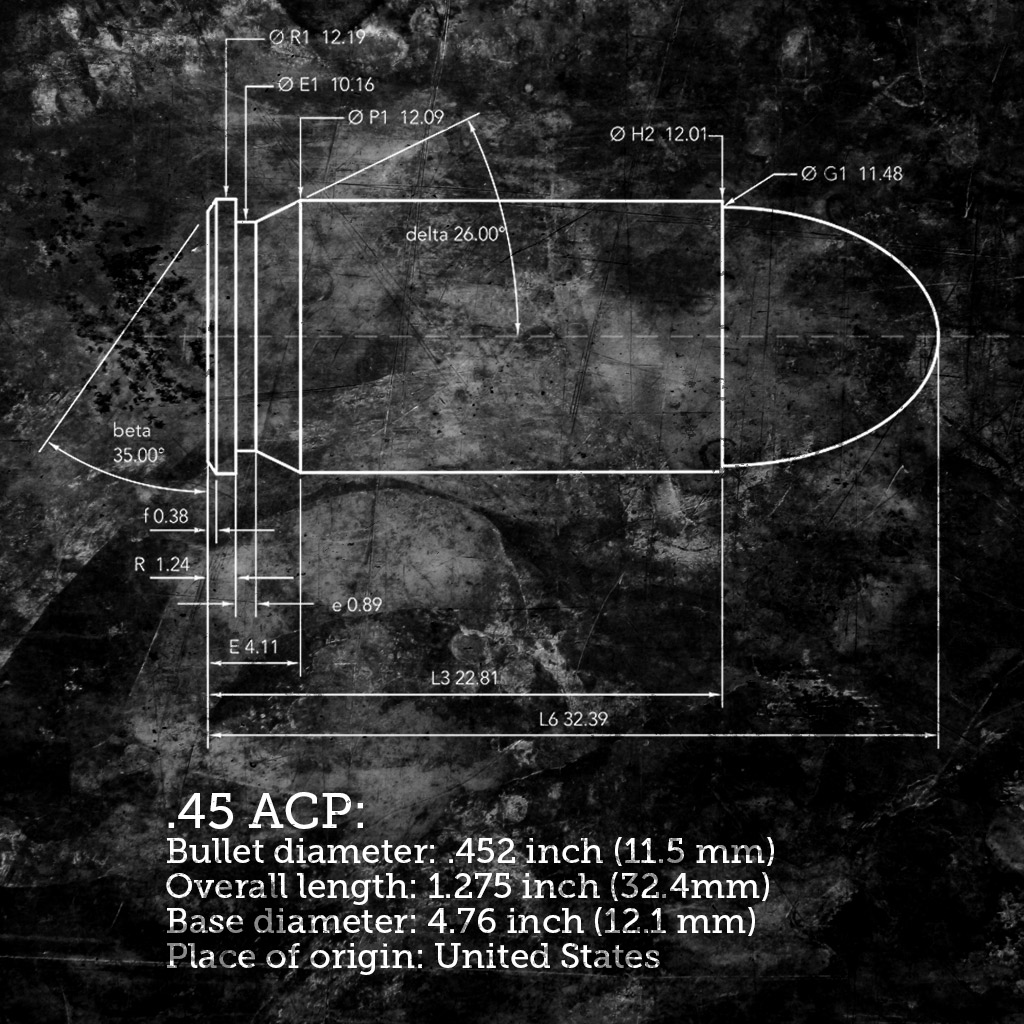
It might be slower than a 9mm cartridge, but the .45 ACP is a two-time World War champion.
The conception of the .45 Auto is one of the many technical marvels from the brain trust of Mr. John Browning. His idea originally was to replace the fairly impotent .38 Long Colt used in the M1892 Army & Navy revolver. What he created was a cartridge that had practical application in a wide variety of different firearm platforms. While revolvers would continue to serve faithfully on the duty rigs of America’s cops for many decades, the militaries of the world had already determined the wave of the future for sidearms to be semi-automatic.
The .45 ACP was mated up to the well-balanced and accurate semi-auto 1911 handgun, it was then quickly adapted to the submachine gun in the form of the Thompson .45 machinegun. The “Tommy Gun” as it became known, was invented in 1918 during the first World War by John T. Thompson. Through the process of engineering, its evolution was perfected during the course of WWII. It was actually invented to be used as a trench gun in WWI, but the war was already over by the time prototypes could be shipped to battlefield locations.
| Cartridge Specs | .45 ACP |
|---|---|
| Parent Casing | N/A |
| Bullet Diameter | .452″ |
| Neck Diameter | .473″ |
| Base Diameter | .476″ |
| Case Length | .898″ |
| Overall Length | 1.275″ |
| Grain Weight | 90-230gr |
| Max Pressure (SAMMI) | 21,000 PSI |
Understanding Bullet Weight
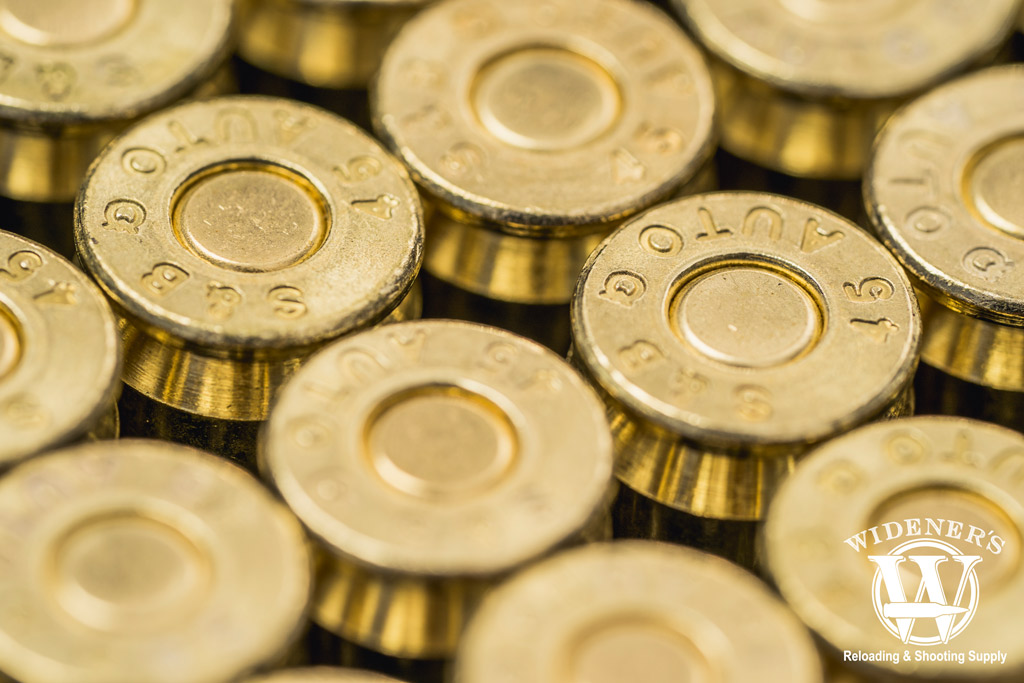
If you were issued a Colt 1911 in the military, there’s a good chance you were carrying 230gr FMJ ammo.
Federal is known for having a good eye for critical ballistic details when designing ammunition. Using a nickel-plated brass case for reliable feeding, the HST line of ammunition employs a deep cavity along with internal and external skiving. The HST round has cannelure locks to ensure the bullet is locked to the case for optimum performance. The muzzle of velocity of 890 fps and 404 ft/lbs are consistent with most 230gr standard pressure JHPs.
There are some standard bullet weights that major commercial ammo makers produce the best 45 ACP ammo in. But these days, it’s not hard to find some hand-loaders creating their own 45 auto custom loads for specific pistols. In the commercial market, only two weights are really common: 185 grain and 230 grain.
185 Grain Loads
The 185 grain slugs are often ramped up to +P pressures to create the highest velocities in the caliber. They carry energy levels solidly in the 400 ft/lb range. Not too shabby for use in close quarters combat and considering these have been proven effective over the course of many years. However, most ammunition in this weight are not +P. The standard 185gr JHP produces performance in the range of 950 fps and around 375 ft/lbs of energy. The venerable .45 is not that ballistically different than the .40 S&W, its far closer to that than the ultra-potent 10mm.
230 Grain Loads
230 grain is the original weight which was settled upon during 1911 development. It remains the standard weight for most applications to this day. As stated earlier, there are other weights for different applications but these two are the most prolific core weight classes commonly in production.
The funny thing about the .45 ACP is how it seems to punch way above its weight class. Well, sort of. It is a big, heavy projectile that at least on paper, does not have the most impressive of mathematical ballistics. But the old adage holds true, that there is no replacement for displacement. Buddy let me tell you, this round will punch holes in and obliterate almost anything you point it at. That big bore heavy slug just has a knack for knocking over assailants and keeping them down on the ground for the count.
Recoil with the .45 ACP is always a question that comes up, at least with more novice shooters. Seasoned shooters know the .45 ACP is not vicious. In a full-size 1911 pistol, it gives you a good vibration, but most shooters have no problem staying on target. Heavy bullets recoil differently than light, fast bullets; they tend to have more of a perceived “push” than a sharp snap. A lot of this really just depends on the size, experience and sensitivity of the shooter, too. Some shooters are very sensitive to felt recoil and others are not, it depends on the person and their training.
45 ACP VS 9mm
The 9mm Parabellum is fascinating. It took American shooters by storm in the 1980s after Glock came into existence and Beretta was selected to produce the next duty sidearm for the U.S. military. It was the age of the Wonder Nine, even though the 9x19mm had been used in Europe for nearly 80 years. However, it fell from favor in the 1990s after real-world experience showed that 9mm ball ammunition lacked the consistency to put down a human target efficiently. However, major advances in modern ammunition have transformed the 9mm into a highly effective caliber. It works very well in almost every application as long as it’s limitations are respected.
It has been an excellent submachine gun caliber for decades from the MP40 to the MP5 and Uzi. More recently, it has been adopted to the Stoner AR-pattern rifle platform, as well as a few other carbines. It is a great high-capacity duty caliber, and functions wonderfully in ultra-compact concealed carry pistols.
Is the .45 ACP still a good choice?
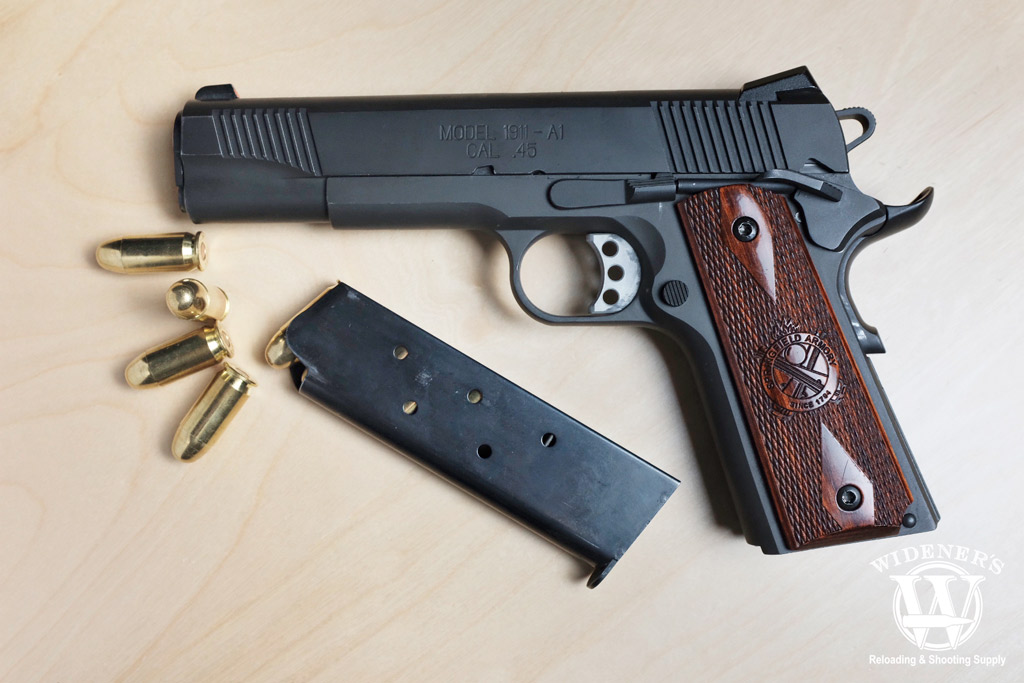
Is the form and function of the 1911 still the best choice for the .45 ACP cartridge?
The Ford F-150 was introduced in 1975 and remains the most popular vehicle sold in America to this day. At 43 years old, is it still a good choice? That market says it is. The same holds true for the well-aged and seasoned .45 ACP. It remains a good choice for those wanting a pistol that has earned a reputation for knocking down assailants quickly in battle. Where it really shines is in single-stack pistols where capacity limits are less pronounced than in larger double-stack pistols.
Take a look at the .45 ACP M&P 2.0 series by Smith & Wesson. The full-size version holds the standard 17+1 in 9mm, but only 10+1 in the comparably sized M&P45. Conversely, the single stack sub-compact M&P Shield 2.0 carries 6+1 in .45 ACP, but only 7+1 in 9mm. If you can handle the recoil of a 230-grain bullet and land accurate follow-up shots, it’s hard to find an argument against owning a .45 ACP pistol.
Conceal Carry Options
.45 ACP single-stack CCW pistols are available from a variety of trusted manufacturers. A .45 ACP sub-compact recoils only slightly more than a comparable .40 S&W with considerably more lead leaving the barrel. The compact single-stack is a tremendous asset. It offers nearly the entire capacity of a 9mm or .40 S&W with a significantly larger slug. This may be null against intelligent bipedal threats who understand cover. However, it might mean a whole lot for CCL holders who live in bear or feral hog country, places with predators who require large, hard-hitting slugs.
Last but not least, some shooters just prefer the heft of the combat-proven 1911, and its exemplary wartime record. Call it nostalgia if you will, but it’s hard to go wrong with a classic. It’s the gun that was strapped to the sides of brave men storming the beaches of Normandy. Perhaps we are not experiencing the twilight of the .45 ACP; if anything, it might be a new dawn for this legendary round.
Military History
The .45 ACP went on to serve a very long and distinguished career in the U.S. military. From carbines to pistols, it was the choice of many a platoon headed into battle. The M1911 chambered-in .45 automatic was the standard duty sidearm until late 1986. It was replaced by the 9mm Beretta M9 (a move which was unpopular with many service members). The Thompson also served well, staying in until nearly the end of the Vietnam war where it was a popular weapon for various military branches. It was not unusual to see the Thompson in Vietnam carried over-the-shoulder by helicopter pilots or by Navy men patrolling boats and shorelines.
Big Bore Champion
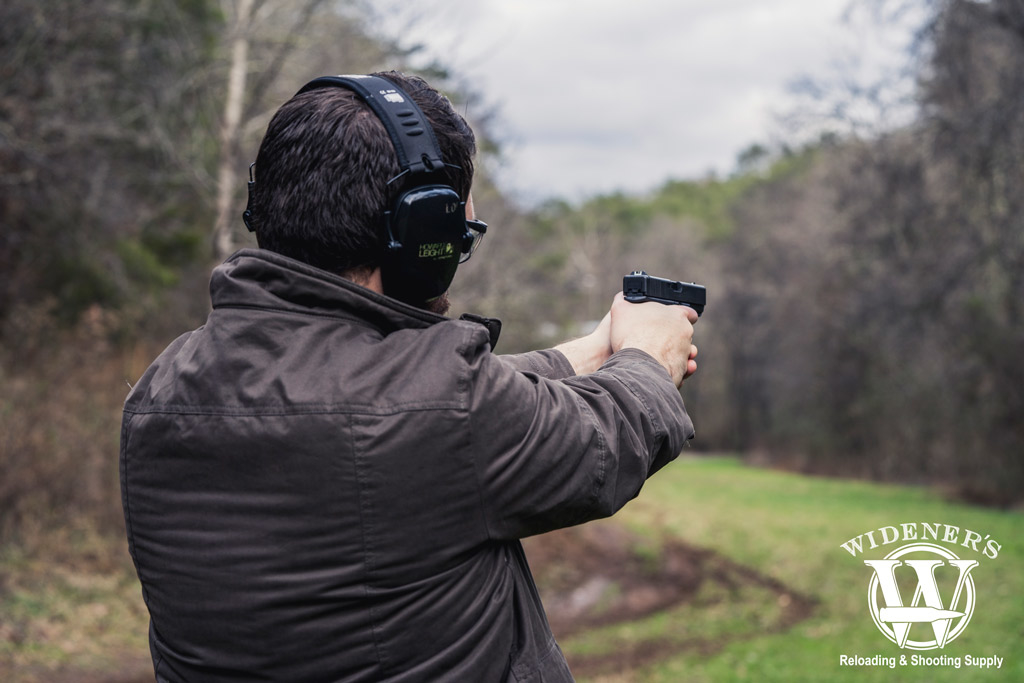
Whether you prefer the classic 1911, or the design of the Glock 21, the .45 ACP is a power-house round.
The question is often asked of whether or not the .45 ACP remains a viable self-defense caliber. All you need is one trip to the range to know. Not only is it viable, it is still a top contender.
As with other bullet designs, modern engineering has taken old and made it new, fierce and imposing. Manufacturers continue to churn out new guns and ammo designs for the legendary .45 ACP. It may have been retired by the military, but it is not going quietly or gently into the good night. Consider also the abundance of available gear easily found for classic .45 pistols, most notably the 1911. You can build a complete 1911 from parts kits, from 80% lowers, or make anything you want. From a basic G.I. service model, all the way to a full custom competition rig. The sky’s the limit.


